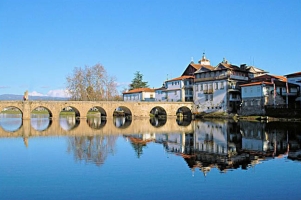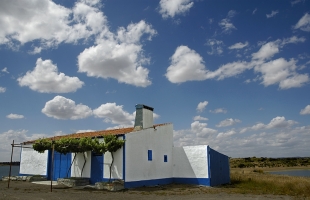COMIDAS REGIONAIS DE PORTUGAL
Regional dishes of Portugal
by Giovanni PereiraClick on the SEARCH icon and enter his ID number (22763) to be taken to his personal page

Chaves
|
Jean Anderson, one of the best food writers in America and a regular visitor to Portugal for over thirty years had this to say about the lusty food of Portugal. "To dine in Portugal is to taste the presence of other countries, other cuisines. It is to conjure up images of an empire... Brazil, Angola, Moçambique, Goa. These and others all belonged to Portugal and in a manner of speaking, each helped to stir the pot." |
Then of course there is the influence of the Moors who occupied Southern Iberia for well nigh five hundred years. These factors account for such diversities in savoury Portuguese dining as:
- Spicy Sausage and Cabbage Soup ( title="green soup">Caldo Verde made from Galician kale) in Minho,
- Slippery Tripe (Dobrada) from Porto,
- Appetising Cured Ham (Presunto) from Chaves,
- Roast Suckling Pig (Leitão Assado) from Bairrada,
- Elegant Reds (Vinho Tinto) from Douro especially the incomparable Barca Velha,
- Moscatel Dessert Wine from Setúbal,
- Silky Mountain Cheese (Queijo da Serra) from Serra da Estrela,
- Pork with Clams (Carne de Porco á Alentejana) from Alentejo
- Almond Sweets (Doces de Amêndoa) from the Algarve.
For a country no larger than the state of Alabama, the scope of culinary delights is truly surprising and it may be of interest to highlight some of the regional specialities in food and wine in this and subsequent efforts...

Alentejo house
|
ALENTEJO À MESA Alentejo, literally 'beyond the Tejo' (the river Tagus which goes by Lisboa its way to the Atlantic Ocean) is the largest and flattest of the provinces of Portugal, dotted with cork oak and olive trees with flocks of sheep and herds of black pigs. It is often overlooked by visitors, even as they make their way from Lisboa to the sunny shores of the Algarve, now only two hours away with the recently completed motorway. Granted some may well have broken off their journey south in historical Evora, a walled city since Roman times and the one time preferred residence of kings going back to the Burgundy and Avis dynasties as well as the Pousada (Inn) dos Loíos, formerly a convent! |
It is true the Alentejo was once a forgotten corner of Continental Portugal, despite its size which is about the same as that of Belgium. The pace of life is certainly less than hectic. After all the food is hearty, peasant fare and the wine full-bodied and fruity. To state the Alentejanos are laid back would be a disservice, for they are indeed hard-working and energised despite the torrid summers when temperatures are often over 40°C but regrettably the jokes still make the rounds. Like the one about a race between the Alentejano and the snail. The snail wins, right? Wrong. The Alentejano wins. How come? you might well ask. The snail was disqualified for two false starts!
The traditional food of Alentejo, not surprisingly, has nothing to do with modern culinary trends. Local people are still content to use local ingredients to create hearty, satisfying meals.

Bridge in Alentejo
|
Pork is likely to confront you in every repast wherever you go. After all, the Alentejo is home to the black pig, very likely fed exclusively from falling acorns (bolotas) from the cork oaks as well as roots, producing some of the best pork imaginable. The most famous of pork dishes in the Alentejo is migas. Be warned, it's heavy, so best try it in winter. Made from any combination of loin, leg or ribs, it is marinated in a garlic and red pepper paste and fried in lard! In classic migas, bread is mixed with water and fried till it becomes a golden, crusted omelette shape. The meat goes on top. But all year round, there's açorda, the basis of which is chunks of stale bread and a mixture of water, olive oil, salt, garlic, and fresh coriander and for some, topped with a poached egg! In summer gaspacho is very popular but unlike the Spanish, it comes in chunks of onions, tomatoes, cucumbers, green peppers floating freely in chilled water, seasoned with garlic, vinegar and salt. Locals often transform it into a main meal with paio (smoked sausage made from fine loin meat as opposed to chouriço which is a rough smoked sausage made from a mixture of meat, fat and nerves, presunto, and carapauzinhos fritos (fried baby horse mackerel) Then, there is the renowned Carne de Porco à Alentejana which is a unique combination of pork and clams. |
For appetizers (petiscos) Alentejanos favour Pig's Liver Salad (Figado de Porco de Coentrada) which is grilled pig's liver, with raw onion,coriander, garlic, olive oil and vinegar. Orelhas (pig's ears) and Polvo (octopus) are often done in the same way.
The Alentejo is also sheep and goat country, so there's Ensopado de Borrego (stewed breast of lamb cutlets served over a slice of bread) and Cabrito Assado, roast kid cooked in white wine, paprika and potatoes till the meat falls from the bone.
Don't ask for fresh fish unless you happen to be by the western seaboard of the Alentejo, so for most, if it's fish you want, it'll be Bacalhau (salted cod) and the way they prefer it is boiled with vegetables.
The sweet dishes are invariably very sweet and almost all with plenty of egg yolks (gemas), sugar, almonds and dusted with cinnamon (canela). Many of the native cakes and desserts are named after convents so, for the less adventurous, one can still fall back on such staples as arroz doce (rice pudding), pudim flan (crême caramel) and mousse de chocolate.
If you like to enjoy a cake with your midday coffee, be it a bica (expresso) or a café com leite (coffee with milk), ask for um pastel or dois pasteis de nata, the small custard-filled puff pastry tarts that seem to have caught on just about everywhere abroad these days.
When it comes to wine, the Alentejo is now one of the great red wine making areas of Portugal. Always a region known for its robust, fruity wines, it has become an area producing fine wines made almost exclusively from indigenous grapes and with its slately soil, their unique taste.
Situated within easy reach of Evora for example, there's Borba to the northeast, Vidigueira to the south and just a convenient drive away is Reguengos de Monsaraz, home to Herdade de Esporão. Covering some 650 hectares or about 1500 acres, Herdade de Esporão, is run by Australian David Baverstock who came to Portugal originally to work in making Port. The winery welcomes visitors and there's an excellent restaurant on the premises.
Here is a selection of wines one might like to try in restaurants.
|
Ordinary Table Wine
Both Red and White
Requengos
Porta da Ravessa
Borba
|
Mid-range
Red
Monte Velho
Borba Reserva
Alabastro Reserva
Requengos Reserva
White
Monte Velho
Vidigueura Vila dos Gamas
Cartuxa
|
Superior
Red
Esporão Reserva
Tapada de Coelheiros
Mouchão
White
Esporão
Quinta do Carmo
|
Don't worry if you've had too much to eat or drink in the Alentejo. After all you just covered one third of the whole country! Bom apetite.